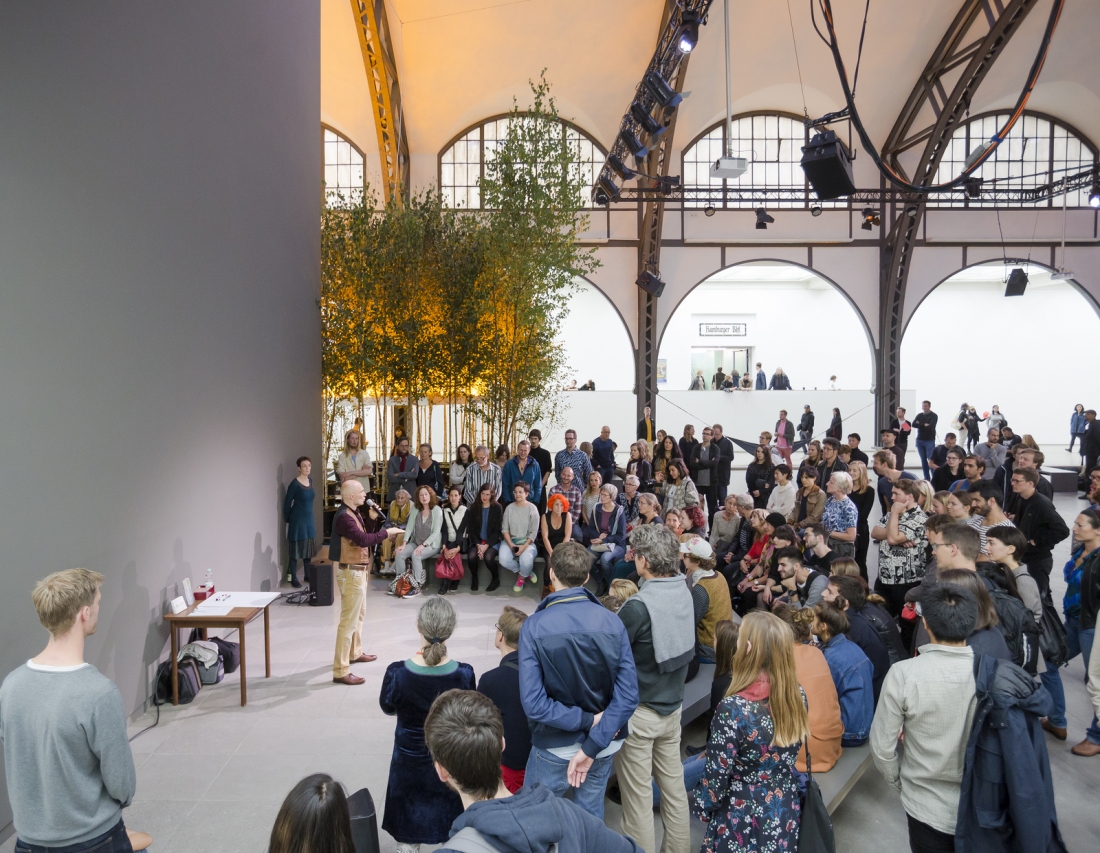ENGLISH
Sound Performance: choreographed by Eric Ellingsen and performed by Miroslav Großer (and friends).
Air, body, breath, ears, perceiving
Miroslav Großer teaches overtone singing. Overtones are harmonic partials—complex tones — produced within a system of resonance. A fundamental note becomes the perceived foundation stabilizing sounds that seem to whistle and trill in precisely perceived proportions; proportions which some feel are governed by some mysterious yet immanently embodied Musica Mundana.
In speaking out, words shape busts of air literally forcing one’s vocal folds to vibrate. Overtone singing is the precise practice of the simultaneous perception and production of sound forces. It is a relational choreography of vibrant things constrained through the coordinated postures of tongue, lip and folded breathing, producing a timbral melody layered in waveforms.
Greatly inspired since last century by the documentary Genghis Blues, Eric found Miroslav Großer in Berlin and began taking overtone singing lessons in 2011. It blew his mind. Eric was co-directing and teaching learning at the Institut für Raumexperimente at the time he met Miroslav. There was a ‘Sound Marathon’ in the works and bringing in teachers to teach how to learn how to learn how to listen was common practice at the Institut; learning how to listen and then materialize one’s imagination by sculpting volumes of materials constrained by and constraining real forces around one with some goal of beauty perhaps; a reproduction of forces perhaps even generating conditions for the return of that nefarious and abstract loss of AURA last century.
Eric learned from Miroslav that all the overtones are already present in each person’s voice. That we are volumes of space spacing out. That in order to be able to reproduce overtones one has to be able to hear them. That in order to hear the sound forces that are already around us, one has to practice the force of listening.
A Listening Practice consists of multiple phases. First comes RECOGNITION, a reconnaissance in thinking. Second comes IDENTIFICATION. By recognizing the overtones in one’s voice, one can then learn how to identify which pitches are being produced and then isolate the precise harmonics one desires. Third comes practice, fourth comes practice, fifth comes fifths. What resonates with you.
DEUTSCH
Gardens of Harmonic Delights Galore ist eine von Eric Ellingsen choreografierte Klangperformance, die von Miroslav Großer (und Freund*innen) performt wird.
Luft, Körper, Atem, Ohren, Wahrnehmung
Miroslav Großer lehrt Obertongesang. Obertöne sind harmonische Teiltöne – sogenannte Teilschwingungen – innerhalb eines Resonanzsystems. Ein Grundton bildet das wahrgenommene Fundament, das Klänge stabilisiert, die in genau wahrgenommenen Verhältnissen wie ein Pfeifen oder Trillern klingen. Verhältnissen, die sich für manche wie eine mysteriöse, doch immanent vorhandene Musica Mundana anhören.
Beim Sprechen erzeugen Wörter in uns Luftbewegungen, die die Stimmlippen in Vibration versetzen. Das Praktizieren von Obertongesang erfordert eine gleichzeitige präzise Wahrnehmung und Produktion von Klang. Er besteht in einer relationalen Choreografie dynamischer Elemente, die mithilfe eines koordinerten In-Positur-Bringens von Zunge, Lippen und Atmung eine Melodie erzeugt, die aus mehreren überlagerten wellenförmigen Klangfarben besteht.
Nachdem er bereits früher durch den Dokumentarfilm Genghis Blues auf das Thema aufmerksam wurde, lernte Eric in Berlin Miroslav Großer kennen und begann 2011, bei ihm Obertongesangsstunden zu nehmen. Von Miroslav lernte Eric, dass in jeder Stimme alle Obertöne bereits vorhanden sind. Dass man Obertöne heraushören können muss, wenn man sie selbst hervorbringen will. Dass man die Kraft des Zuhörens aufbringen muss, will man die Klangkräfte hören, die uns bereits umgeben.
Eine Hörübung besteht aus mehreren Phasen. Erstens: Erkennen, eine Erkundung im Denken. Zweitens: Identifizieren. Indem man die Obertöne in der eigenen Stimme erkennt, kann man lernen, die genauen Tonhöhen zu identifizieren, die entstehen, und dann die präzisen Harmonien isolieren, die man erzeugen will. Drittens: üben. Viertens: üben. Fünftens: Fünftel. Was klingt bei Ihnen nach.

